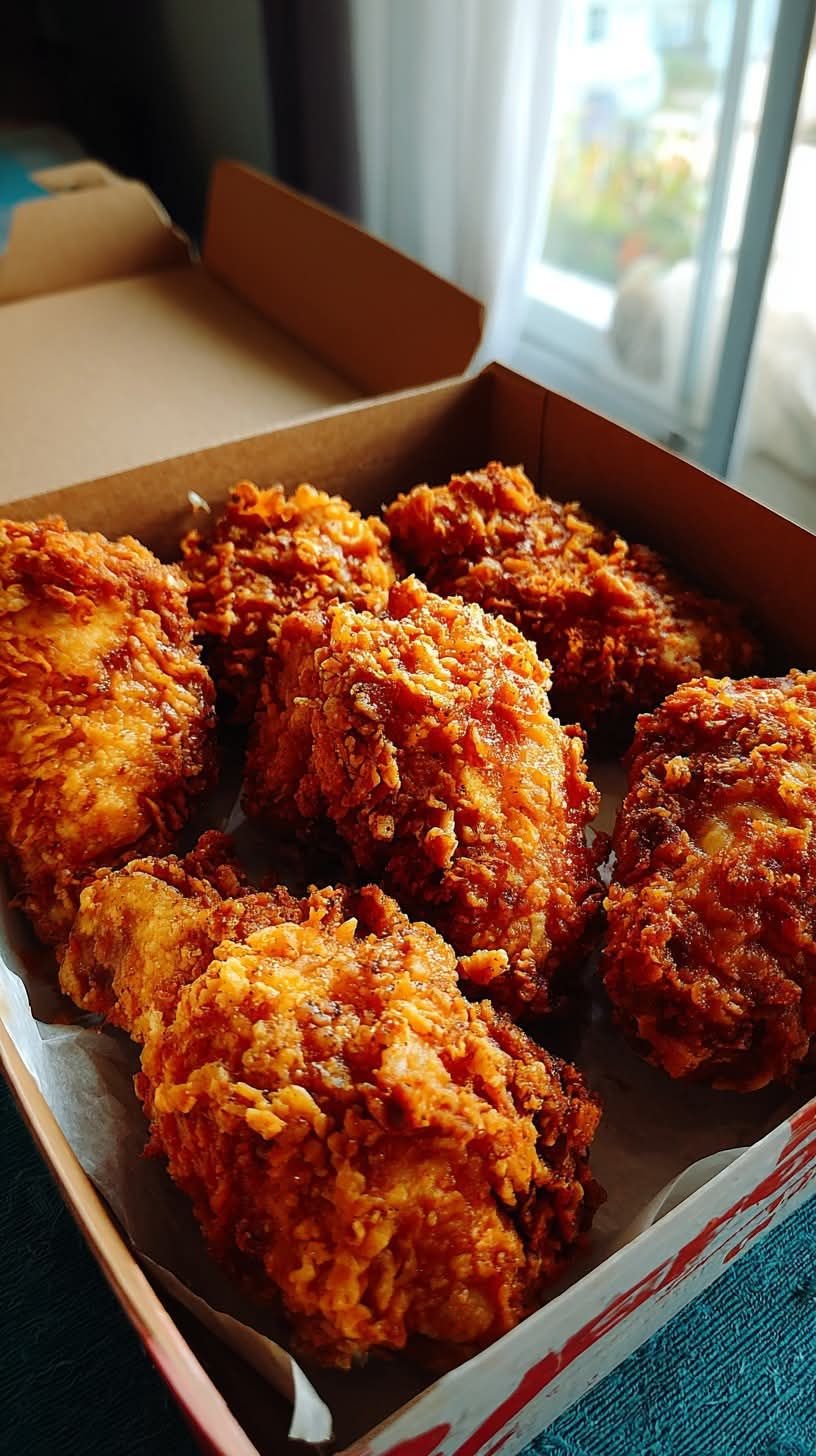
The Ultimate Crispy Fried Chicken Recipe: Secrets to a Golden, Crunchy Crust
By Jason Griffith, Professional Food Writer
There is no dish more iconic, more universally loved, or more deeply comforting than a perfect piece of fried chicken. It’s the centerpiece of countless family picnics, Sunday dinners, and celebratory feasts. But achieving that elusive, ultra-crispy crust and juicy interior can feel like a culinary challenge. I’m here to tell you it’s not. With a couple of simple secrets—a buttermilk soak and a little cornstarch—you can create a batch of Crispy Fried Chicken that rivals any you’ve had from a restaurant.
This isn’t just a recipe; it’s a technique honed over years of experimentation, aiming for the perfect balance of seasoning, tenderness, and crunch. Forget the fast-food version; this is the real deal.
Why I Love This Recipe
This recipe is built on two pillars of great fried chicken:
- The Buttermilk Soak: Marinating the chicken in buttermilk is non-negotiable. The mild acidity naturally tenderizes the meat, ensuring every bite is incredibly juicy. It also acts as the “glue” that helps the seasoning-rich flour mixture adhere, giving us a thick, craggy crust.
- The Cornstarch Boost: The addition of cornstarch to the flour mixture is the golden ticket to maximum crispiness. It lowers the gluten content, preventing the crust from becoming tough, and ensures a shatteringly crisp texture that stays crunchy even as the chicken cools.
It takes a little time, especially for the soak, but I promise the results are worth the wait.
Ingredients for Crispy Fried Chicken
| Ingredient | Quantity | Notes |
| Chicken Pieces | 3 lbs | A mix of drumsticks, thighs, breasts, or wings works best. Bone-in pieces provide the most flavor. |
| Buttermilk | 2 cups | This is essential for tenderizing. If you don’t have it, use 2 cups of milk with 1 tbsp of lemon juice or white vinegar. |
| All-Purpose Flour | 2 cups | The base of our flavorful coating. |
| Cornstarch | 1/2 cup | The secret ingredient for extra crunch and crispiness. |
| Garlic Powder | 2 tsp | A deep layer of savory flavor. |
| Onion Powder | 2 tsp | Complements the garlic for a classic seasoning profile. |
| Paprika | 2 tsp | Adds color and a subtle sweetness. |
| Cayenne Pepper | 1 tsp | Optional. Use if you want a little kick of heat. |
| Salt | 2 tsp | Don’t skimp on the salt—it’s crucial for flavor. |
| Black Pepper | 1 tsp | Freshly ground is best. |
| Vegetable Oil | For frying | Use a high smoke point oil like vegetable, canola, or peanut oil. |
Export to Sheets
Swaps and Notes
- For a spicier crust: Increase the cayenne pepper to 2 tsp, or add 1 tsp of chili powder or hot smoked paprika.
- Gluten-Free Option: You can substitute the all-purpose flour and cornstarch mixture with a gluten-free all-purpose blend that contains xanthan gum. The texture will be slightly different but still delicious.
- Buttermilk Substitute: If you’re out of buttermilk, mix 2 cups of regular milk with 1 tablespoon of white vinegaror lemon juice. Let it sit for 5 minutes until it curdles slightly.
- Oil Choice: Peanut oil is the preferred choice of many pros for its clean flavor and high smoke point, but vegetable or canola oil is a perfect substitute.
Step-by-Step Directions
1. Marinate the Chicken (The Crucial Step)
Place your chicken pieces in a large bowl or a resealable bag. Pour the buttermilk over the chicken, ensuring all pieces are fully submerged. Cover and refrigerate for at least 1 hour. For the absolute best results and tenderness, marinate overnight (up to 24 hours).
2. Prepare the Coating
In a shallow dish (a pie plate or baking dish works well), whisk together the flour, cornstarch, garlic powder, onion powder, paprika, cayenne pepper (if using), salt, and black pepper. Make sure everything is thoroughly combined.
3. Coat the Chicken
Remove one piece of chicken from the buttermilk, letting the excess liquid drip off. Place it directly into the flour mixture. Press firmly to ensure the coating adheres to every surface. For an extra-crispy, craggy crust, dip the coated chicken piece back into the buttermilk briefly (just a quick dip) and then dredge it in the flour mixture a second time, pressing again. Place the coated chicken on a wire rack while you prepare the remaining pieces.
Pro Tip: Let the coated chicken sit on the rack for 10–15 minutes before frying. This allows the coating to dry slightly and adhere better, reducing the chance of it falling off in the oil.
4. Heat the Oil
In a deep, heavy-bottomed skillet or Dutch oven, pour in 2–3 inches of vegetable oil. Heat the oil over medium-high heat until it reaches 350∘F (175∘C). Use a kitchen thermometer to monitor the temperature—this is vital for perfect chicken.
5. Fry the Chicken
Carefully place the chicken pieces into the hot oil, ensuring you do not overcrowd the pan. Overcrowding drops the oil temperature, leading to greasy, soggy chicken. Fry in batches.
- Fry larger pieces (thighs, breasts) for 12–15 minutes, turning halfway.
- Fry smaller pieces (drumsticks, wings) for 8–10 minutes, turning halfway.
The chicken is done when the crust is a deep golden-brown and the internal temperature reaches 165∘F (74∘C) in the thickest part of the meat (avoiding the bone).
6. Drain and Serve
Using tongs, remove the fried chicken and immediately place it on a wire rack set over a baking sheet. This allows air to circulate underneath, keeping the bottom crisp. Do not drain on paper towels, as this traps steam and makes the bottom soggy. Serve hot!
Tips for Success
- Temperature Control is King: Keep your oil as close to 350∘F as possible. If it gets too low, the crust will absorb oil and become greasy. If it gets too high, the crust will burn before the meat cooks through. Adjust the heat as needed between batches.
- The Double Dip: Don’t skip the double-dredge for maximum crunch. It makes all the difference in building that thick, flavorful crust.
- Resting Time: Allowing the coated chicken to rest for 10–15 minutes before it hits the oil is a chef’s secret for ensuring the coating sticks perfectly.
- Even Cooking: For breast pieces, slice them horizontally into thinner cutlets (or “tenderloins”) to ensure they cook at the same rate as the darker meat.
Serving Suggestions and Pairings
Crispy Fried Chicken is the perfect meal on its own, but it truly shines with classic, comforting sides.
Classic Southern Sides:
- Creamy mashed potatoes and gravy
- Tangy coleslaw
- Fluffy biscuits
Heartier Pairings:
- A side of Classic Spaghetti Recipe with Homemade Sauce
- A comforting bowl of This Cajun Chicken Sausage Gumbo is My Favorite Bowl of Southern Comfort
Refreshments & Desserts:
- Wash it down with a glass of crisp, sweet This Blueberry Lemonade is My Favorite Refreshing Drink for Sunny Days.
- Finish the meal with a slice of This Big Family Banana Pudding is My Favorite Classic Dessert to Feed a Crowd.
Nutritional Information Per Serving (Estimate)
(Based on a 4 oz thigh piece)
| Nutrient | Amount |
| Calories | 380 |
| Protein | 30g |
| Fat | 25g |
| Saturated Fat | 6g |
| Carbohydrates | 10g |
| Sodium | 600mg |
Export to Sheets
Note: This is an estimate and will vary significantly based on the size of the chicken piece, the exact amount of coating absorbed, and the oil used.
Storage and Leftover Tips
Fried chicken is best enjoyed immediately, but leftovers are fantastic!
- Storage: Store cooled fried chicken in an airtight container in the refrigerator for up to 3–4 days.
- Reheating (The Key to Crispness):Never reheat in the microwave—it will become soggy. For crispy results, reheat in an oven or air fryer.
- Oven: Preheat to 375∘F (190∘C). Place the chicken on a wire rack over a baking sheet. Bake for 10–15 minutes until heated through and the crust is crisp again.
- Air Fryer: Reheat at 350∘F (175∘C) for 5–7 minutes.
More Recipes You Will Love
If you enjoy simple, comfort food with chicken, you’ll definitely want to try these other favorites:
- Easy Cheesy Chicken Sliders with Marinara Garlic Butter
- This Cajun Chicken Sausage Gumbo is My Favorite Bowl of Southern Comfort
Final Thoughts
Fried chicken is a dish that speaks to the soul. It’s a labor of love, requiring patience and a respect for the process. Once you master the technique—the buttermilk soak, the cornstarch in the coating, and the oil temperature control—you’ll have a recipe you’ll pass down for generations.
Give this recipe a try, and let me know how it turned out! Tag us in your pictures and share your best sides in the comments below. Happy frying!




Leave a Reply